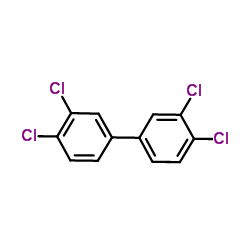3,3',4,4'-Tetrachlorobiphenyl

3,3',4,4'-Tetrachlorobiphenyl structure
|
Common Name | 3,3',4,4'-Tetrachlorobiphenyl | ||
|---|---|---|---|---|
| CAS Number | 32598-13-3 | Molecular Weight | 291.988 | |
| Density | 1.4±0.1 g/cm3 | Boiling Point | 380.7±37.0 °C at 760 mmHg | |
| Molecular Formula | C12H6Cl4 | Melting Point | 182-184℃ | |
| MSDS | Chinese USA | Flash Point | 188.4±23.9 °C | |
| Symbol |


GHS08, GHS09 |
Signal Word | Warning | |
|
Polychlorinated biphenyl 77 augments angiotensin II-induced atherosclerosis and abdominal aortic aneurysms in male apolipoprotein E deficient mice.
Toxicol. Appl. Pharmacol. 257(1) , 148-54, (2011) Infusion of angiotensin II (AngII) to hyperlipidemic mice augments atherosclerosis and causes formation of abdominal aortic aneurysms (AAAs). Each of these AngII-induced vascular pathologies exhibit pronounced inflammation. Previous studies demonstrated that ... |
|
|
Biotransformation of 2,2',5,5'-tetrachlorobiphenyl (PCB 52) and 3,3',4,4'-tetrachlorobiphenyl (PCB 77) by liver microsomes from four species of sea turtles.
Chem. Res. Toxicol. 24(5) , 718-25, (2011) The rates of oxidative metabolism of two tetrachlorobiphenyl congeners were determined in hepatic microsomes from four species of sea turtles, green (Chelonia mydas), olive ridley (Lepidochelys olivacea), loggerhead (Caretta caretta), and hawksbill (Eretmoche... |
|
|
Differential sensitivity of CYP1A to 3,3',4',4-tetrachlorobiphenyl and benzo(a)pyrene in two Lepomis species.
Comp. Biochem. Physiol. C. Toxicol. Pharmacol. 152(1) , 42-50, (2010) Although Lepomis species are abundant in a wide variety of habitats throughout North America and could serve as potentially valuable biomonitoring tools, few studies have examined the induction of pollutant biomarkers in this genus. We hypothesized that the i... |
|
|
Lack of CYP1A responsiveness in species inhabiting chronically contaminated habitats: two varieties of resistance?
Comp. Biochem. Physiol. C. Toxicol. Pharmacol. 157(2) , 212-9, (2013) Organisms chronically exposed to organic pollutants such as polychlorinated biphenyls (PCBs) can develop resistance to these chemicals, a condition associated with reduced inducibility of the biomarker enzyme cytochrome P450 1A (CYP1A). This study addresses t... |
|
|
Identification and mRNA expression of pi-class glutathione S-transferase and selenium-dependent glutathione peroxidase in the gudgeon Gobio gobio exposed to PCB 77.
Comp. Biochem. Physiol. C. Toxicol. Pharmacol. 155(2) , 300-6, (2012) In aquatic environments some pollutants are present in water and sediments and organisms possess cellular detoxification systems to face up these xenobiotics. The gudgeon, Gobio gobio, is a freshwater benthopelagic fish that appears particularly adequate for ... |
|
|
Increased proliferative effect of organochlorine compounds on human preadipocytes.
Mol. Cell Biochem. 365(1-2) , 275-8, (2012) Chlorinated persistent organic pollutants, commonly referred to as organochlorine compounds (OCs), are chemicals of environmental concern that were mostly used historically as pesticides, solvents, flame retardants, and other applications, though some still c... |
|
|
Selection of DNA aptamers against polychlorinated biphenyls as potential biorecognition elements for environmental analysis.
Anal. Biochem. 423(2) , 195-201, (2012) Polychlorinated biphenyls (PCBs) have been of major concerns for decades due to their potential toxicity to human health. To trace the PCBs efficiently and sensitively, many detection methods have been developed. Aptamers, a new class of diagnostic tools, are... |
|
|
The effect of olestra on the absorption, excretion and storage of 2,2',5,5' tetrachlorobiphenyl; 3,3',4,4' tetrachlorobiphenyl; and perfluorooctanoic acid.
Environ. Int. 36(8) , 880-3, (2010) Mice were gavaged with either (14)C-labeled 2,2'5,5' tetrachlorobiphenyl; 3,3',4,4' tetrachlorobiphenyl; or perfluorooctanoic acid. Absorption of these compounds was determined by assay of feces collected for 48 h after the gavage. Part of the animals receive... |
|
|
Insight on the interaction of polychlorobiphenyl with nucleic acid-base.
J. Mol. Model. 19(2) , 581-8, (2013) The interaction between one polychlorobiphenyl (3,3',4,4',-tetrachlorobiphenyl, coded PCB77) and the four DNA nucleic acid-base is studied by means of quantum mechanics calculations in stacked conformations. It is shown that even if the intermolecular dispers... |
|
|
Acute alteration of cardiac ECG, action potential, I(Kr) and the human ether-a-go-go-related gene (hERG) K+ channel by PCB 126 and PCB 77.
Toxicol. Appl. Pharmacol. 262(1) , 60-9, (2012) Polychlorinated biphenyls (PCBs) have been known as serious persistent organic pollutants (POPs), causing developmental delays and motor dysfunction. We have investigated the effects of two PCB congeners, 3,3',4,4'-tetrachlorobiphenyl (PCB 77) and 3,3',4,4',5... |